Scratch Shockwave Original Design / Scratch Built
Scratch - Shockwave {Scratch}
Contributed by Joseph Michel
| Manufacturer: | Scratch |
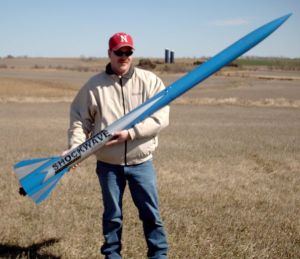 Description:
Description:
Shockwave is a scratch-built high power rocket built for the purpose of
obtaining Level 2 certification. It is 4" in diameter, 90" long,
weighs 153oz loaded without motor, and has a 54mm motor mount.
Components:
Like my Level 1 rocket, I used mostly PML components for this build. This
included the body tubes, centering rings, motor tube, and altimeter bay
components. The .093" G-10 fins were custom cut by Red Arrow Hobbies. The
9/16" tubular nylon harnesses came from Giant Leap, and the 72" main
chute came from Sphereachutes.
Construction:
I started with the motor mount. I used six PML centering rings, gluing them
together in pairs. The top centering ring was drilled for a U-bolt. The motor
mount tube was cut to 30" long, and top and mid-section centering rings
were epoxied on. The fins were tacked to the motor tube using gel super glue
then filleted in place with 30-minute
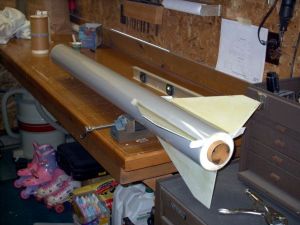 epoxy. At
this point, the fin can was more or less complete. A 46" long piece of
Quantum Tubing was used for the lower section, and a 26" piece of QT was
used for the payload section. The fin slots were cut with a Dremel tool and the
motor mount/fin assembly installed. Internal fillets from the fins to the
inside of the body tube were completed before installing the rear centering
ring. An Aeropack motor retainer finished off the back end.
epoxy. At
this point, the fin can was more or less complete. A 46" long piece of
Quantum Tubing was used for the lower section, and a 26" piece of QT was
used for the payload section. The fin slots were cut with a Dremel tool and the
motor mount/fin assembly installed. Internal fillets from the fins to the
inside of the body tube were completed before installing the rear centering
ring. An Aeropack motor retainer finished off the back end.
The altimeter bay was fabricated from a standard 7" long PML coupler, two PML bulkheads, and two coupler bulkheads. The bulkheads and coupler bulkheads were glued together in pairs to make a cap for each end of the bay. Both caps were drilled for U-bolts and permanent e-match terminals.
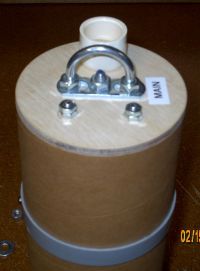
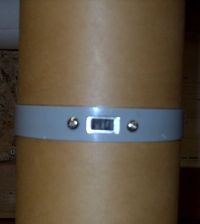
An 8 1/2" length of 1/4" x 20-threaded rod was affixed to the drogue end of the bay. This would serve to tie the entire bay together and provide a mount for the RRC2 altimeter. A small slice of body tube was placed on the outside of the bay to give a place to mount an external switch for the altimeter. 3/4" PVC endcaps were mounted on each end of the bay to contain the ejection charges.
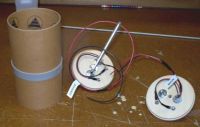 Three holes
were drilled through the altimeter bay with the payload section installed on
the main side on the bay. 8-32 nuts were epoxied to the inside of the altimeter
bay to retain the payload section. Three equally spaced 1/8" static ports
were also drilled. To finish the bay, a thin skin of 30-minute epoxy was poured
in the drogue side of the bay with the cap installed. This step totally seals
the drogue side of the bay, and retains the endcap. A mount for the RRC2
altimeter was made by epoxying a copper tube to a piece of G-10 fiberglass. The
mount slides in over the center stud and is locked down with a washer and nut.
Three holes
were drilled through the altimeter bay with the payload section installed on
the main side on the bay. 8-32 nuts were epoxied to the inside of the altimeter
bay to retain the payload section. Three equally spaced 1/8" static ports
were also drilled. To finish the bay, a thin skin of 30-minute epoxy was poured
in the drogue side of the bay with the cap installed. This step totally seals
the drogue side of the bay, and retains the endcap. A mount for the RRC2
altimeter was made by epoxying a copper tube to a piece of G-10 fiberglass. The
mount slides in over the center stud and is locked down with a washer and nut.
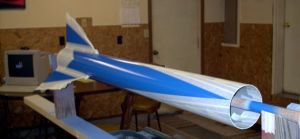
Finishing:
Shockwave was finished with a modified Estes Executioner-style paint job, in
blue and sliver with black pinstriping. I made some custom decals with inkjet
waterslide decal stock to give it a nice finishing touch.
Flight:
After slowly building Shockwave most of the winter, flight day finally arrived
on March 20th, 2004. I arrived at the launch and rounded up a few friends to be
my certification team. After aceing the written L2 test, I began careful prep
of the dual deployment recovery system. This flight would have a PML streamer
deploying at apogee with motor backup, and main deployment at 500ft. Drogue and
main harnesses are both 25ft in length. After the recovery system was buttoned
up, I turned attention to loading the motor. This flight would be on a CTI
3-grain Pro54 motor. Once the motor was loaded and installed, we took a few
pictures and headed to the pad. The day turned out to be a real bummer
weather-wise, with strong 20MPH winds. With the help of my test proctor and a
friend, Shockwave was put on the pad, and the igniter installed. I armed the
electronics, verified the RRC2 was beeping right, and headed back the LCO
table.
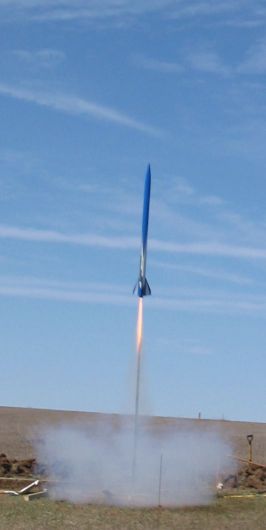 Considering
the strong wind and the fact that my friend's L2 attempt earlier in the day was
a spectacular failure, I was getting nervous at this point. Countdown
commences, I and crossed my fingers! The LCO pushes the button....nothing. Try
again, nothing. After fiddling with some wires on the launch controller, the
LCO tries again. Finally, the big J295 awakens with the thunderous roar, and
Shockwave is on its way! The rocket had a very straight accent considering the
strong winds.
Considering
the strong wind and the fact that my friend's L2 attempt earlier in the day was
a spectacular failure, I was getting nervous at this point. Countdown
commences, I and crossed my fingers! The LCO pushes the button....nothing. Try
again, nothing. After fiddling with some wires on the launch controller, the
LCO tries again. Finally, the big J295 awakens with the thunderous roar, and
Shockwave is on its way! The rocket had a very straight accent considering the
strong winds.
Recovery:
The streamer deployed right on queue, and the descent began. After falling for
what seemed like an eternity, the main chute deployed and Shockwave had a
gentle touchdown about 1/2 mile away. Upon recovery, the rocket had no damage
except for a few scuffs on the paint. The RRC2 was beeping out 4,686ft. A
successful flight and Level 2 certification!
Summary:
This project sure has taught me a lot. Some will tell you that a certification
flight should be as simple as possible, without electronics and with the
smallest motor available for the certification being sought. While there is
merit to that opinion, I felt that I was up to the challenge. This flight was
full of firsts for me. My first experience with dual-deployment, altimeters,
and CTI motors. I also achieved a new personal altitude record. I can't wait to
fly it again on a calm day!
PROs:
- Cool looking rocket
- Can be flown single-stage deployment without the payload section and altimeter
- Built tough
- Flies very stable
CONs:
- I can't think of any except cost
Sponsored Ads
 |
 |











